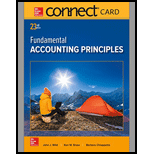
Concept explainers
Concept Introduction:
Asset:
An asset is a resource embodying an economic benefit that is owned and controlled by a business entity. The benefits derived from an asset are generally spread over the useful life of the asset. Assets can be tangible or intangible. In accounting, an asset is a real account and always shows debit balance.
Liability:
Liability is the obligation arising out of carrying business transactions that needs to be settled within a specified period of time. It is the sacrifice of economic benefits in future as the result of an obligation. Liabilities are classified as long term and short term. Liabilities represent real account and always show credit balance.
Equity:
Equity represents the ownership value of the business. In other words, the difference between assets and liabilities of a business is called equity. It is the net asset of an entity.
To determine: The assets, liabilities and equity accounts from the list of items
Want to see the full answer?
Check out a sample textbook solution
Chapter 2 Solutions
Connect Access Card for Fundamental Accounting Principles
- Sullivan Manufacturing uses direct labor hours in its predetermined overhead rate. At the beginning of the year, the estimated direct labor hours were 32,000 hours, and the total estimated manufacturing overhead was $576,000. At the end of the year, actual direct labor hours for the year were 31,500 hours, and the actual manufacturing overhead for the year was $580,000. Overhead at the end of the year was__. a. $16,500 overapplied b. $13,000 underapplied c. $11,000 underapplied d. $10,500 underappliedarrow_forwardGeneral accounting questionarrow_forwardprovide answerarrow_forward
- Please provide the correct answer to this general accounting problem using accurate calculations.arrow_forwardCeltex Manufacturing uses direct labor hours in its predetermined overhead rate. At the beginning of the year, the estimated direct labor hours were 38,400 hours and the total estimated manufacturing overhead was $729,600. At the end of the year, actual direct labor hours for the year were 36,000 hours and the actual manufacturing overhead for the year was $729,600. Overhead at the end of the year was _.arrow_forwardWhat is the total amount of current liabilities?arrow_forward

 AccountingAccountingISBN:9781337272094Author:WARREN, Carl S., Reeve, James M., Duchac, Jonathan E.Publisher:Cengage Learning,
AccountingAccountingISBN:9781337272094Author:WARREN, Carl S., Reeve, James M., Duchac, Jonathan E.Publisher:Cengage Learning, Accounting Information SystemsAccountingISBN:9781337619202Author:Hall, James A.Publisher:Cengage Learning,
Accounting Information SystemsAccountingISBN:9781337619202Author:Hall, James A.Publisher:Cengage Learning, Horngren's Cost Accounting: A Managerial Emphasis...AccountingISBN:9780134475585Author:Srikant M. Datar, Madhav V. RajanPublisher:PEARSON
Horngren's Cost Accounting: A Managerial Emphasis...AccountingISBN:9780134475585Author:Srikant M. Datar, Madhav V. RajanPublisher:PEARSON Intermediate AccountingAccountingISBN:9781259722660Author:J. David Spiceland, Mark W. Nelson, Wayne M ThomasPublisher:McGraw-Hill Education
Intermediate AccountingAccountingISBN:9781259722660Author:J. David Spiceland, Mark W. Nelson, Wayne M ThomasPublisher:McGraw-Hill Education Financial and Managerial AccountingAccountingISBN:9781259726705Author:John J Wild, Ken W. Shaw, Barbara Chiappetta Fundamental Accounting PrinciplesPublisher:McGraw-Hill Education
Financial and Managerial AccountingAccountingISBN:9781259726705Author:John J Wild, Ken W. Shaw, Barbara Chiappetta Fundamental Accounting PrinciplesPublisher:McGraw-Hill Education





